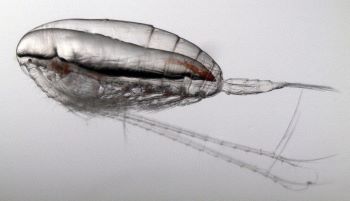
The DMR Division of Marine Mammal Research, Habitat Monitoring Program is focused on habitat and prey related research. The program collects and analyzes oceanographic and zooplankton data throughout the Gulf of Maine to better understand changes in the prey-scape of the endangered North Atlantic right whale (NARW) and inform ecosystem models and predictive forecasting.
Copepods, a type of zooplankton, are a key food source for NARWs, and shifts in their distribution are believed to influence where these whales are found—particularly in areas like the Bay of Fundy and the Gulf of St. Lawrence. One species in particular, Calanus finmarchicus, is especially abundant in the Gulf of Maine. These copepods are notable for their high lipid content, making them an ideal prey item for NARWs.
Since July 2025, DMR has been collecting monthly samples to monitor seasonal patterns in plankton communities. Over time, this effort will help us assess interannual variability and examine how plankton dynamics relate to other oceanographic conditions.
Sampling stations are positioned along an inshore north-south transect to capture the influence of the Maine Coastal Current, including areas in Downeast Maine that have historically been under-sampled. Additional offshore stations in deep basins—specifically Wilkinson Basin and Jordan Basin—will provide insight into diapausing Calanus populations. These plankton are known to form dense aggregations at depth, which are believed to be an important food source for foraging NARWs.

Our sampling program will utilize three pieces of oceanographic equipment to collect data:
- Bongo zooplankton nets: towed vertically from 5-m off the bottom to the surface providing a zooplankton sample of the full water column. Samples will be processed for zooplankton community composition, biomass, and lipid content. The mesh size is 200um matching other ongoing sampling programs (MBON and Canadian AZMP programs).

- CTD with niskin bottles: sensors collect conductivity (a proxy for salinity), temperature, depth, dissolved oxygen, pH, and fluorescence. Water from bottle samplers will be processed for chlorophyll (a proxy for phytoplankton concentrations) and nutrients. These parameters are likely important in understanding changing zooplankton dynamics.

- MultiNet: the multinet is a specialized piece of equipment that contains 5 zooplankton nets that can be shut at specific depths, allowing us to collect depth stratified samples and improve our understanding of dense Calanus aggregations and where they form in the water column. MultiNet sampling will be added to the program soon!